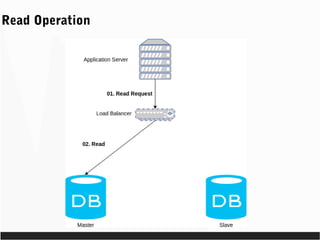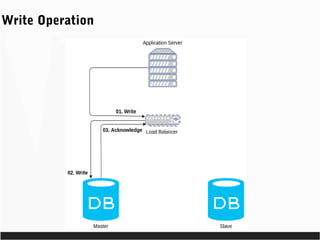Ad
Distributed systems - A Primer
- 1. Distributed Systems – A Primer MD Sayem Ahmed
- 2. Who am I ● A Bangladeshi currently living in Berlin, Germany ● Occasionally blogs at www.codesod.com ● Tweets at @say3mbd ● Can also be found on LinkedIn ● Can be reached via email at [email protected]
- 3. Today’s Agenda ● What are Distributed Systems? ● Why Distributed Systems? ● Read Replication/Single-master Replication ● CAP Theorem ● Sharding/Partitioning/Multi-master Replication
- 4. Distributed Systems – A Definition A distributed system is a collection of independent computers that appears to its users as a single coherent system Distributed Systems: Principles and Paradigms by Andrew S. Tanenbaum, Maarten van Steen
- 5. A Typical Web Application is a Distributed System
- 6. Key Characteristics of Distributed Systems ● Concurrency – all the computers operate at the same time
- 7. Key Characteristics of Distributed Systems ● Concurrency – all the computers operate at the same time ● Transparency – system is perceived as a whole
- 8. Key Characteristics of Distributed Systems ● Concurrency – all the computers operate at the same time ● Transparency – system is perceived as a whole ● Independent failure – the computers can fail independently
- 10. Key Characteristics of Distributed Systems ● Concurrency – all the computers operate at the same time ● Transparency – system is perceived as a whole ● Independent failure – the computers can fail independently ● No global clock
- 12. Back to the Book Shop
- 13. More and more people are using my book shop! But then…. It takes a long time to load the book review pages!
- 14. Book Shop is not scalable! Needs to handle more users!
- 15. What should I scale?
- 18. ● Powerful Application Servers? ● More Application Servers? ● Powerful Database Server?
- 20. Focus on ● Database ● Memory ● CPU ● Network I/O ● Disk I/O
- 21. Performance Measurement – Burning Questions ● Are my database queries slow?
- 22. Performance Measurement – Burning Questions ● Are my database queries slow? ● Is my application’s CPU consumption high?
- 23. Performance Measurement – Burning Questions ● Are my database queries slow? ● Is my application’s CPU consumption high? ● Is my application running out of memory?
- 24. Performance Measurement – Burning Questions ● Are my database queries slow? ● Is my application’s CPU consumption high? ● Is my application running out of memory? ● Does my application have a memory leak?
- 25. Performance Measurement – Burning Questions ● Are my database queries slow? ● Is my application’s CPU consumption high? ● Is my application running out of memory? ● Does my application have a memory leak? ● Is garbage collection being triggered too often?
- 26. Performance Measurement – Burning Questions ● Are my database queries slow? ● Is my application’s CPU consumption high? ● Is my application running out of memory? ● Does my application have a memory leak? ● Is garbage collection being triggered too often? ● Is there something wrong with the Network I/O?
- 27. Performance Measurement – Burning Questions ● Are my database queries slow? ● Is my application’s CPU consumption high? ● Is my application running out of memory? ● Does my application have a memory leak? ● Is garbage collection being triggered too often? ● Is there something wrong with the Network I/O? ● Is there something funny going on with the Disk Usage? Are reading/writing to disks taking too long?
- 28. Performance Measurement – Burning Questions ● Are my database queries slow? ● Is my application’s CPU consumption high? ● Is my application running out of memory? ● Does my application have a memory leak? ● Is garbage collection being triggered too often? ● Is there something wrong with the Network I/O? ● Is there something funny going on with the Disk Usage? Are reading/writing to disks taking too long? ● Are the third-party APIs taking too long to respond?
- 29. Performance Measurement – Burning Questions ● Are my database queries slow? ● Is my application’s CPU consumption high? ● Is my application running out of memory? ● Does my application have a memory leak? ● Is garbage collection being triggered too often? ● Is there something wrong with the Network I/O? ● Is there something funny going on with the Disk Usage? Are reading/writing to disks taking too long? ● Are the third-party APIs taking too long to respond? ● … and so on
- 30. Tools that help to measure ● New Relic / AppDynamics / DataDog ● Metrics (from Dropwizard), Grafana ● Cloud provider tools (i.e., AWS CloudWatch) ● Custom Resource Monitoring Tools
- 31. Some simple scaling strategies ● Try to optimize database queries (more on this later)
- 32. Some simple scaling strategies ● Try to optimize database queries (more on this later) ● Try purchasing more powerful CPUs and more memory (Vertical Scaling) for the application servers (only works for CPU- and memory-bound applications)
- 33. Some simple scaling strategies ● Try to optimize database queries (more on this later) ● Try purchasing more powerful CPUs and more memory (Vertical Scaling) for the application servers (only works for CPU- and memory-bound applications) ● If database is not a bottleneck, try adding more application server instances (Horizontal Scaling)
- 34. Some simple scaling strategies ● Try to optimize database queries (more on this later) ● Try purchasing more powerful CPUs and more memory (Vertical Scaling) for the application servers (only works for CPU- and memory-bound applications) ● If database is not a bottleneck, try adding more application server instances (Horizontal Scaling) ● Try using a CDN to serve static contents
- 35. Most of the time, it is the Database
- 36. Scaling a Single Database – some simple strategies ● Reduce the number of queries
- 37. Scaling a Single Database – some simple strategies ● Reduce the number of queries ● Use indexes
- 38. Scaling a Single Database – some simple strategies ● Reduce the number of queries ● Use indexes ● Make sure your indexes are being used by the queries in production
- 39. Scaling a Single Database – some simple strategies ● Reduce the number of queries ● Use indexes ● Make sure your indexes are being used by the queries in production ● Make sure you are not creating too many indexes on write-heavy tables
- 40. Scaling a Single Database – some simple strategies ● Reduce the number of queries ● Use indexes ● Make sure your indexes are being used by the queries in production ● Make sure you are not creating too many indexes on write-heavy tables ● Try purchasing powerful CPUs and more memories for the database server (Vertical Scaling)
- 41. Scaling a Single Database – some simple strategies ● Reduce the number of queries ● Use indexes ● Make sure your indexes are being used by the queries in production ● Make sure you are not creating too many indexes on write-heavy tables ● Try purchasing powerful CPUs and more memories for the database server (Vertical Scaling) ● … and many more (indexed views, denormalization, store pre- computed value for fast read etc.)
- 43. Scaling Database Reads through Read Replication
- 44. Read Operation
- 45. Read Operation
- 46. Read Operation
- 47. Write Operation
- 48. Write Operation
- 49. Write Operation
- 50. Write Operation
- 51. Write Operation
- 52. Write Operation
- 71. … at the cost of Availability
- 72. There will always be Trade-offs
- 73. It is impossible for a distributed data store to simultaneously provide more than two out of the following three guarantees: CAP Theorem Source: https://en.wikipedia.org/wiki/CAP_theorem
- 74. It is impossible for a distributed data store to simultaneously provide more than two out of the following three guarantees: – Consistency CAP Theorem Source: https://en.wikipedia.org/wiki/CAP_theorem
- 75. It is impossible for a distributed data store to simultaneously provide more than two out of the following three guarantees: – Consistency – Availability CAP Theorem Source: https://en.wikipedia.org/wiki/CAP_theorem
- 76. It is impossible for a distributed data store to simultaneously provide more than two out of the following three guarantees: – Consistency – Availability – Partition Tolerance CAP Theorem Source: https://en.wikipedia.org/wiki/CAP_theorem
- 77. Every read receives the most recent write or an error CAP Theorem - Consistency Source: https://en.wikipedia.org/wiki/CAP_theorem
- 78. Every request receives a (non-error) response – without guarantee that it contains the most recent write CAP Theorem - Availability Source: https://en.wikipedia.org/wiki/CAP_theorem
- 79. The system continues to operate despite an arbitrary number of messages being dropped (or delayed) by the network between nodes CAP Theorem – Partition Tolerance Source: https://en.wikipedia.org/wiki/CAP_theorem
- 80. Read Replication - Advantages ● Can easily handle vast amount of concurrent reads
- 81. Read Replication - Advantages ● Can easily handle vast amount of concurrent reads ● Configuring Redundancy is very easy
- 82. Read Replication - Problems ● Not ACID
- 83. Read Replication - Problems ● Not ACID ● Consistency or Availability – choose one
- 84. Read Replication - Problems ● Not ACID ● Consistency or Availability – choose one ● Increased operational complexity compared to a single database instance
- 85. How do I scale Writes?
- 86. Sharding / Partitioning / Multi-master Replication
- 87. Read/Write Operation User ID IP 1 - 100000 192.168.197.17 100001 - 200000 192.168.197.18
- 88. Read/Write Operation User ID IP 1 - 100000 192.168.197.17 100001 - 200000 192.168.197.18 User ID = 50000
- 89. Read/Write Operation User ID IP 1 - 100000 192.168.197.17 100001 - 200000 192.168.197.18 User ID = 50000
- 90. Read/Write Operation User ID IP 1 - 100000 192.168.197.17 100001 - 200000 192.168.197.18 User ID = 150000
- 91. Read/Write Operation User ID IP 1 - 100000 192.168.197.17 100001 - 200000 192.168.197.18 User ID = 150000
- 92. “I would like to calculate the total revenue earned from Harry Potter and the Deathly Hallows over a certain period”
- 93. Scatter
- 94. Compute
- 95. Gather
- 96. … Aka MapReduce ● Scatter/Gather is famously known as the MapReduce paradigm ● Popularized by a famous research paper from Google ● A popular implementation is part of the Apache Hadoop project
- 97. Sharding – advantages Can easily scale read/write to the Moon
- 98. Sharding – problems ● Operationally complex – Cluster Management – All queries need to have the Shard Key
- 99. Sharding – problems ● Operationally complex – Cluster Management – All queries need to have the Shard Key ● Sharding an RDBMS is painful – Referential integrity cannot be guaranteed anymore
- 100. Sharding – problems ● Operationally complex – Cluster Management – All queries need to have the Shard Key ● Sharding an RDBMS is painful – Referential integrity cannot be guaranteed anymore ● Each table must have the Shard Key
- 101. Sharding – problems ● Operationally complex – Cluster Management – All queries need to have the Shard Key ● Sharding an RDBMS is painful – Referential integrity cannot be guaranteed anymore ● Each table must have the Shard Key ● Not suitable if most of the queries are Scatter/Gather
- 102. Next Topics ● Distributed Hash Tables / Consistently Hashed Data Stores ● Distributed Transactions ● A very brief introduction to Microservices
- 103. Additional Resources ● Distributed Systems in One Lesson by Tim Berglund ● Distributed Systems reading list by Tim Berglund ● Building Microservices by Sam Newman ● PostgreSQL documentation on High Availability ● MongoDB Replication Manual ● High Scalability ● Enterprise Integration Patterns
- 104. Thank you!
- 105. Questions?































































































































































